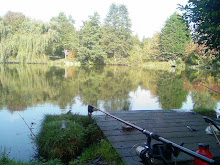Carp are quite gregarious, social creatures, and often shoal up together, but I have noticed on many waters that the larger fish tend to be loners. For this reason it is always worth exploring the deepest, seediest, most overgrown areas of a lake, where a big carp might just think it's hidden away safely.
Many of my angling friends, and many of the anglers I read about speak of the same thing, and it is often the case that the largest fish pop up in the most ignored areas of a lake. These areas are usually extremely cramped, take various whippings from branches across the polaroids to get to, and you can barely fit a chair in let alone a bivvy.
However, these swims can be very profitable, as they are so often overlooked.
I remember reading an article by Ian Poole, about his time on Manor, and how the largest fish were rarely seen with any pals around them. Could this be a case of juvenile carp teasing the larger fish, in the same way as most of us ridicule a sumo wrestler or an obese celebrity? Or is it simply a case that the big carp know that if they get excited into a feeding frenzy by competitive doubles that they will probably end up with a few minutes on an unhooking mat.
I may be that these carp, probably being the older of the carp, just like a bit of peace and quiet, away from noisy youngsters and even noisier anglers. Either way, this brings me to my point about using the margins to stalk your quarry.
Chances are, the first few times you went fishing, you walked along the bank and scared the living daylights out of numbers of margin carp on seperate occasions. I still do it from time to time, missing opportunities as I do so, and it really gets to me.
The margins are the biggest feature on any lake, you can fish gravel bars and islands all day, but chances are, nearly every fish in the lake will visit some area near the bank at some point, every single day.
But how should you approach it? Well there are many ways you can go about it, from the elaborate ways written about by Sheringham (Which I wont go into) or the straightforward 'hunter' approach.
We have all heard the quote by Isaak Newton, "Study to be quiet", and Isaak couldn't have put it any better. The slightest movement can spook a carp, but sound is of the most importance, as even the slightest twig break can send a carp bolting off into the depths never to return.
You must really envisage yourself as a 'stalker', like a hidden hitman, an assassin, but one who catches carp. You need to be invisible.
That brings me onto the 'invisibility factor', which is mainly a rig and bait matter.
Right, you've been perfectly silent, and you've found a 30lb common sitting around 6 foot away from you, you've found it, but how are you going to catch it?
In this situation the introduction of freebies could prove the kiss of death, especially with large baits like boilies, however baits like maggots, or casters, should float down silently enough, and naturally enough, to not cause a great disturbance to the carp.
Maggots are a great line of attack when stalking, and I rarely look any further unless I have already baited a spot beforehand, which I will talk about later. They are something similar to what carp will come across in a natural food larder, and for some reason, carp really wolf them down!
Mathew Woods



No comments:
Post a Comment
Please keep your comments clean and informative - Thanks, Gary.